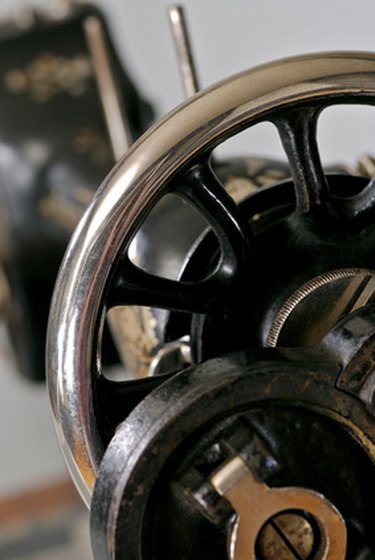
The Singer Company has earned a reputation as a quality builder and supplier of sewing machines since 1851. The Singer Featherweight 221 is a strong, sturdy machine built of steel parts with a steel casing. These machines are wildly popular with collectors and home sewers, as they are easy to maintain and simple to fix. The Singer Featherweight 221, with proper maintenance, can last for years and rarely malfunctions. When it does, however, it is usually something that can be corrected quickly and easily.
Step 1
Take out the bobbin as well as the bobbin housing. When the top thread moves through the bobbin mechanism, it can become tangled or hung up on lint or thread. Cleaning the bobbin space corrects this condition.
Video of the Day
To clean out the bobbin casing, remove the presser foot as well as the needle. Remove the bobbin housing plate, on the lower front left of the machine. Remove the bobbin from its case. Thoroughly clean the bobbin case as well as the region right behind bobbin case using a small to medium sized lint brush. Wipe the bobbin case with a soft piece of fabric, such as flannel. Put the bobbin, bobbin case and bobbin housing back in place and replace the needle and presser foot.
Step 2
Look at the needle. Quite a few issues with a Singer Featherweight 221 are due to the needle becoming dull or misshapen--or being improperly installed. The Singer Featherweight 221 uses universal machine needles; however, be certain that you're utilizing a needle suitable for your sewing project. If you do not know the proper needle size for your project, check with the owner's manual. When you put in the needle, make sure that the smooth side of the shank faces the back of the Featherweight. Also ensure that the needle is attached firmly in place with the needle clamp, which is located above the needle and to the right.
If your Featherweight 221 still fails to work correctly, change the needle. Occasionally needles get just a little bit bent while you sew, and changing them corrects the issue.
Step 3
Remove all the thread and rethread your Featherweight 221. Thread occasionally gets trapped around the thread spool, inside the tension knobs as well as in several other areas. Rethreading the machine allows the thread to move smoothly through the machine. Whenever you rethread, be sure to thread the needle properly so that the thread starts off to the left of the needle eye and is drawn through to the right, leaving a minimum thread end of eight inches.
Step 4
Alter the tension on the machine. Tension settings are frequently to blame for missed stitches as well as puckered seams. Begin by changing the tension setting to three, which is the midpoint tension setting on the Featherweight 221. Tension setting requirements change depending on the fabric and thread used, so you may need to change your tension setting frequently. To check the tension, stitch a straight seam. Your stitches should be flat on the front and back sides without any raised lumps. Gradually fine-tune the tension, trying out every setting with a new pair of stitches and modifying until each side of the stitches lay completely flat.
Step 5
Oil your machine. The Singer Featherweight 221 requires regular oiling to keep it in top shape. If it feels rough when running or jerks around, oil all moving parts of your machine with sewing oil.
Video of the Day